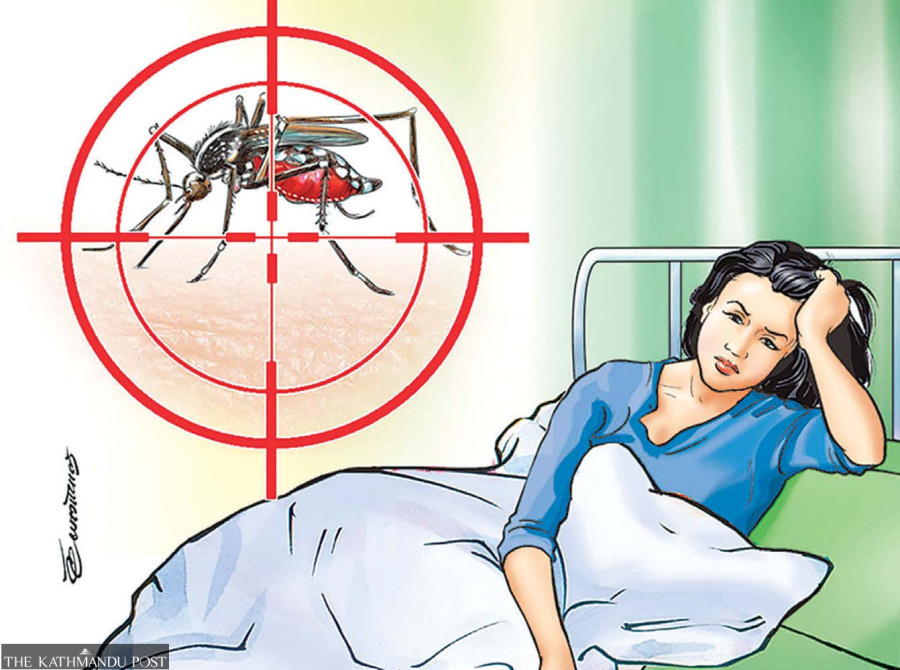Health
Nepal not doing enough to combat dengue epidemic, say doctors
Thirteen persons have died and around 19,000 got infected with the virus that has spread to 75 of country’s 77 districts.
Arjun Poudel
At least 13 persons have died and around 19,000 have been infected so far this year by the dengue virus that has spread to 75 districts of the country. Humla and Mugu districts of Karnali Province haven’t yet reported the virus.
Officials, however, believe that it is just a matter of time, as vectors spreading the dengue virus are prevalent in all districts.
“Dengue virus has emerged as a major public health problem in our country,” said Dr Gokarna Dahal, chief of the Vector Control Section at the Epidemiology and Disease Control Division. “This is the second consecutive year in which we have seen a major outbreak of the dengue virus.”
Epidemiologists as well as virologists said the dengue virus has emerged as a major public health problem in Nepal of late as the disease becomes endemic. They said that despite thousands of persons getting infected and scores dying from dengue, the authorities concerned have not taken the issue seriously.
Dr Biraj Karmacharya, chief of the Department of Community Programmes at Dhulikhel Hospital echoed sentiments similar to Dahal’s. He said: “Dengue has emerged as a major public health concern in our country, but we don’t know how prepared our health system is for dealing with the new challenges.”
Last year, 88 people died and more than 54,000 were infected by the virus, which had spread to all 77 districts of the country. Hospitals in Kathmandu Valley were overwhelmed with dengue patients and many complained that they were being deprived of treatment. At the time, pharmacies had run out of paracetamol, the most widely used medicine to treat fever.
The dengue outbreak in 2019 killed at least six people and more than 16,000 were hospitalised. The virus had spread to 68 districts at the time.
This year, Sunsari district has become the epicentre of the dengue outbreak, recording 9,906 cases of infection, which is 53 percent of the total cases reported across the country so far.
The BP Koirala Institute of Health Sciences was overwhelmed with the infected patients.
Experts say the lackadaisical approach of the concerned authorities is responsible for the spread of the dengue virus. They say extensive measures—dengue search-and-destroy and awareness drives—should be initiated to contain the spread of virus-spreading vectors.
“The health workers should reach out to every household to request people to keep their surroundings clean,” said Karmacharya. “Political parties, which reach out to every household for votes during the elections should mobilise their volunteers in the drive against dengue.”
Unless the lessons are learnt and experiences gained during the previous outbreaks are implemented, the disease will not stop spreading, said the experts. They reckon the real number of infected persons could be several times higher as the government’s case reporting system is not very effective and more than 80 percent of the cases are asymptomatic. Many people infected with dengue show mild symptoms and do not need any treatment or can be treated with paracetamol at home.
“Not only dengue, the outbreaks of other vector-borne diseases could also increase in coming days, as the climate favours it,” said Dr Sher Bahadur Pun, chief of the Clinical Research unit at the Sukraraj Tropical and Infectious Disease Hospital.
A report by the United Nations “Climate Change 2022: Impacts, Adaptation and Vulnerability” states that at least six major vector-borne diseases have recently emerged in Nepal and are now considered endemic, with climate change implicated as the primary driver.
The report also shows increasing evidence that climate warming has extended the elevational distribution of Anopheles, Culex and Aedes mosquitoes, which carry viruses, above 2,000 metres in Nepal.
Officials at the division said that three other districts—Dhading, Morang and Jhapa—have reported more than 500 cases of infections. Kathmandu has recorded 406 cases while Lalitpur has reported 160 cases so far.
Dengue is a mosquito-borne disease transmitted by female Aedes aegypti and Aedes albopictus mosquitoes. The same vector also transmits chikungunya, yellow fever, and Zika, according to the World Health Organisation.
Dengue-transmitting mosquitoes breed in clean water and bite people in broad daylight. Uncovered water tanks and discarded objects such as plastic cups and bottles could be breeding grounds for dengue-carrying mosquitoes.
According to doctors, mild to high fever, severe muscle pain, rashes, severe headache and pain in the eyes are some symptoms of dengue. Doctors advise that patients with these symptoms should seek immediate treatment. While there is no specific cure for the disease, early detection and access to proper medical care can lower fatalities.




 9.12°C Kathmandu
9.12°C Kathmandu














